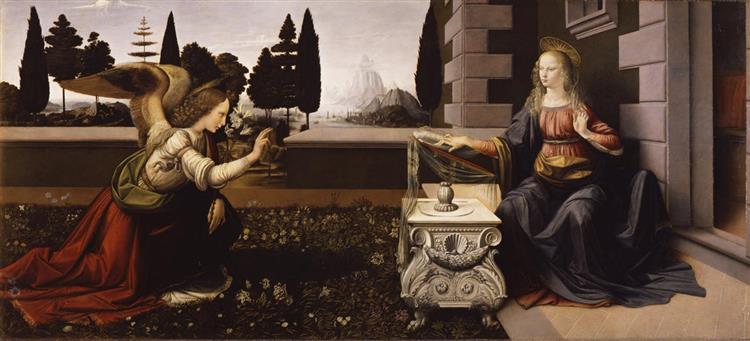Annunciation
Uffizi Gallery, Florence, Italy
Vinci Leonardo da, 1472
Annunciation (ca. 1472) is one of Leonardo da Vinci’s earlier works, which was commissioned by the church of San Bartolomeo in Monte Oliveto. Leonardo painted with oil and tempera on wood, an untraditional choice since oil was usually used on canvas. From its rectangular shape and size, the painting was likely intended for the sacristy (a room where priests prepare for service and objects of worship are held) of the newly renovated church. Prior to 1869, Annunciation was attributed to Florentine painters like Domenico Ghirlandaio and Andrea Verrocchio. However, radiographic and spectrographic tests as well as newly discovered preparatory sketches indicate that Leonardo painted Annunciation while he was training in the workshop of Andrea Verrocchio. Various sketches by Leonardo, Lily (1473-1475), The Study of a Sleeve (1473), The Study of a Drapery of a Figure Kneeling (1473) and The Study of Drapery of a Seated Figure (1473) demonstrate his extensive preparatory work for Annunciation.The depicted scene is based on the New Testament: the Angel Gabriel visits the Virgin Mary announcing to her that she was chosen by God to be the mother of his Son. Leonardo demonstrates innovation and creativity in his composition, which differs from the traditional depictions of the Annunciations, such as Filippo Lippi’s Annunciation (1445) and Fra Angelico Annunciation (ca. 1435), that portray an interior setting with a partial view of a landscape. Leonardo’s Annunciation is in an open courtyard of a Renaissance palace with a Tuscan landscape and seascape in the background. The landscape was painted in the sfumato technique, which softens the transition between colors, so the human eye does not perceive boundaries and lines. Through this technique, Leonardo captured the diffusion of air changes, giving the illusion of a continuous flow of air and mist.Leonardo carefully conceived each element in the Annunciation, making complex connections to the life and death of Christ. For instance, the carpet of spring flowers relates to the religious scene: the lily whites, daisies, white champions, morning glories and lavender all symbolize the Virgin’s innocence and purity. Other flowers, such as irises, passion flowers and myositis are associated with her feeling of love and mourning. Another important element in Annunciation is the marble lectern placed between the Virgin Mary and the Angel Gabriel. The lectern is a combination of a Renaissance baby cradle and a sarcophagus, thus it symbolizes both the birth and death of Christ. This is also seen in other paintings like Raphael’s The Holy Family of Francis I (1518) and Lorenzo Lotto’s Virgin and Child with Saints Jerome and Nicholas of Tolentino (1524). Leonardo decorated the lectern with classical motifs like acanthus leaves, garlands, scallop shells and lion’s paws. In its design, the lectern is reminiscent of the sarcophagus designed by Verrocchio for Giovanni de’ Medici (1472) at the Old Sacristy in the Church of St. Lorenzo in Florence. By placing the lectern in a blooming meadow, Leonardo adds another layer of meaning: the lectern alludes to a mortuary and Christ’s death, while the flowers symbolize the present moment and his life.
